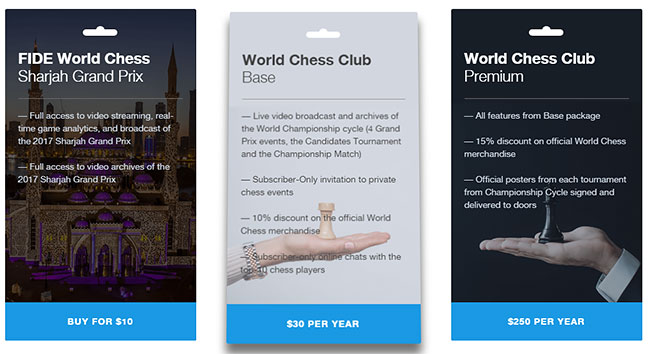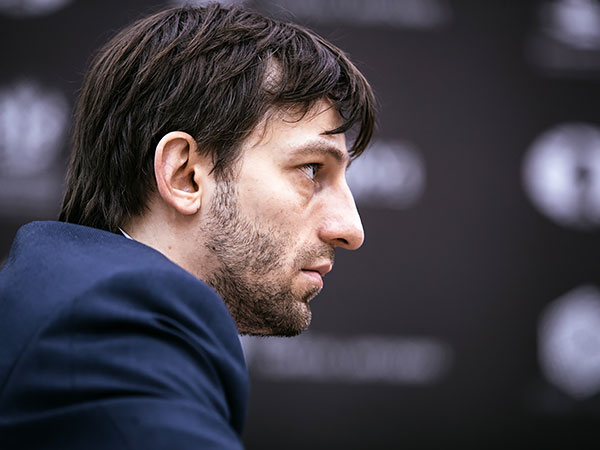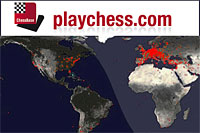The time control in the GP tournaments is 100 minutes for the first 40 moves, 50 minutes for the next 20 moves and then 15 minutes for the rest of the game plus an additional 30 seconds per move starting from move one.
The first leg, in Sharjah, will be held February 18-27 (with a rest day on the 23rd) at the Sharjah Cultural & Chess Club. The first prize is €20,000; the total prize fund is is €130,000.
2017 Sharjah GP Participants
All photos by Max Avdeev

Although Riazantsev's game was the shortest of the day, if anyone could be forgiven for this, it was him. After suffering three consecutive defeats, all the Russian Champion wanted was to put a stop to the rot.

The Frenchman Maxime Vachier-Lagrave had started with great panache, but after two opening wins, he has not played seven straight draws

In spite of a modest plus one score, Nepomniachtchi is one player with chances at the podium

Alexander Grischuk and Shakhriyar Mamedyarov played the most interesting game of the day, not least because of the important result

Annotating the crucial and complex bout is Tiger Hillarp Persson
A. Grischuk vs S. Mamedyarov (annotated by Tiger Hillarp-Persson)

[Event "FIDE World Chess Grand Prix 2017"] [Site "Sharjah"] [Date "2017.02.26"] [Round "8"] [White "Grischuk, Alexander"] [Black "Mamedyarov, Shakhriyar"] [Result "1-0"] [ECO "B14"] [WhiteElo "2742"] [BlackElo "2766"] [Annotator "Tiger Hillarp"] [PlyCount "120"] [EventDate "2017.??.??"] 1. d4 Nf6 2. c4 e6 3. Nf3 d5 4. Nc3 c5 5. e3 ({The more popular line} 5. cxd5 Nxd5 6. e4 Nxc3 7. bxc3 cxd4 8. cxd4 Bb4+ 9. Bd2 Bxd2+ 10. Qxd2 O-O {is frequently seen at the top and leads to positions where White has to keep up the pressure or accept an early draw. Grischuk's choice is more of a let's-play-a-long-game-and-see-who's-best kind of move.}) 5... Nc6 6. cxd5 Nxd5 ({The alternative is to play} 6... exd5 {, when} 7. Bb5 Bd6 8. O-O O-O 9. dxc5 Bxc5 10. b3 Bg4 11. Bb2 {leads to positions where White keeps some positional pressure without taking much of a risk.}) 7. Bd3 (7. Bc4 {is another standard move that has become less popular. The reason might be that after} cxd4 8. exd4 Be7 9. O-O O-O 10. Re1 Bf6 {White has run out of practical move that doesn't involve moving either Bc4 or Nc3 and after} 11. Ne4 b6 {is it suddenly quite unclear why the bishop was any better off on c4. It should have been in order to undermine d5, but d5 stays solid:} 12. Nxf6+ Nxf6 13. Bg5 Bb7 14. d5 Na5 $1) 7... cxd4 8. exd4 Bb4 (8... Be7 9. O-O O-O 10. Re1 Bf6 11. Be4 Nce7 12. Qd3) 9. O-O $1 {Although this isn't exactly a novelty, it is the first time someone tries it at such a high level. It makes a lot of sense to play this move if it isn't good for Black to take the pawn. So, is it?} ({A famous option is} 9. Qc2 Ba5 10. a3 Nxc3 11. bxc3 Nxd4 12. Nxd4 Qxd4 13. Bb5+ Bd7 14. O-O $13 {which has been played in more than a hundred tournament games.}) (9. Bd2 {is another recurring move.}) 9... O-O {It seems that Mamedyarov didn't fancy entering a position where Grischuk might have something sharp prepared. Still, this move surprised me, as it give White virtually an extra tempo on the lines where White protects c3.} ({The game Nikolenko,O (2534)-Kharitonov,A (2548) Moscow 2010, saw} 9... h6 {; a move that aims to once again force White into protecting c3. However, White continued in logical fashion with} 10. Bc2 $1 { and Black soon found himself in a bad situation:} Be7 {(now Black has lost 2 (!!) tempi on a normal line)} (10... Bxc3 11. bxc3 Nxc3 12. Qd3 Nd5 {looks logical and might even set a question mark on whether it was such a great idea to play Bc2.}) 11. a3 Nf6 12. Qd3 b6 13. Ba4 Bd7 14. d5 exd5 15. Nxd5 Ne5 16. Nxf6+ Bxf6 17. Bxd7+ Nxd7 18. Rd1 Qc7 19. Qe4+ {and Black resigned.}) 10. Bc2 { The World Blitz 2016 saw 2 games with this position, though through a different move order where Black played 0-0 before Nc6. This make the sacrifice of a pawn at c3 less strange, as there is a Bxh7+/Qc2 tactic that works for White.} Bd7 (10... Be7 11. Qd3 g6 12. a3 Nxc3 (12... Qb6 $5) 13. bxc3 b6 14. Re1 Bb7 15. h4 $6 {Typical idea, although more common before Black plays g6.} Bxh4 16. Nxh4 Qxh4 17. Re3 Ne7 $2 18. Rg3 $1 {Black's queen is in trouble.} Nf5 19. Bg5 Qh5 20. Bd1 Nxg3 21. Qxg3 {1-0 (21) So,W (2770)-Nakamura, H (2785) Ultimate Blitz Challenge 2016}) (10... Nf6 11. Re1 h6 12. Qd3 Bd6 13. Ne4 Nxe4 14. Qxe4 f5 15. Qe2 Nb4 16. Bb3 Nd5 17. Bd2 Bd7 18. Ne5 Rf6 19. Qf3 Bc6 20. Nxc6 bxc6 21. Rac1 Rc8 22. Rc2 Qb6 $2 23. Rxe6 $1 {1-0 (23) Ivanchuk,V (2745)-Anand,V (2775) World Blitz 2016}) 11. a3 Bxc3 ({It is a question of taste whether one prefers} 11... Be7 {or the move in the game. However, after retreating the bishop Black is a temp down (a3) on a line where Be7 is played immediately on move 8. Does that mean that it is bad? No, not really, but Bd7 looks pretty passive.}) 12. Qd3 f5 $5 {A principled defence. Mamdeyarov is giving up some dark square in order to be able to control the light squares.} 13. bxc3 b5 $1 14. a4 $1 a6 ({The engine comes up with} 14... Rc8 $5 15. axb5 Na5 {, when Black's grip on the light squares makes it hard for White to claim anything but a modest advantage. After} 16. Bd2 Nc4 17. Bb3 Bxb5 18. Rfc1 a6 { there's a lot to be played for still.}) 15. Re1 Qc7 16. Ng5 $5 {In a senes this is a difficult position for White, since there are so many good moves to chose from. You know that you are better and want to find a move that proves it. And, while you find one after another move that is just that; better, you fail to find one that is better than the rest. The clock ticks...} ({Instead, the natural} 16. Bb3 {, leads to a forced variation:} Na5 17. Bxd5 exd5 18. Ba3 Rfe8 19. axb5 axb5 20. Bb4 Nc4 {, where it is not clear that White's advantage will win the game.}) 16... Qd6 ({There is something to be said for the seemlingly passive} 16... Nd8 {, as it gains a tempo on the c3-pawn and thus a tempo for the defence. After} 17. Bd2 Rc8 {Black is set to take on a4 and swap off as much as possible of the queenside. With the queenside gone, Black's chances of survival increases rapidly, as there is only one weakness in his position (e5).}) 17. Qd2 $5 {A very strange move that I would sure have put a "?!" to, if it wasn't that my respect for this guy is just too big for that. I guess he had a chat with his pieces and the queen said: "I don't belong here".. . "but I still need to keep an eye on c3". Perhaps what happened was quite another story.} ({The simple} 17. Bb3 {looks like a good alternative. To my understanding, after f5 is played, the bishop c2 is more misplaced than the queen.}) 17... h6 18. Nf3 {Back to square... f3.} Rfc8 {Black has managed to get some coordination and is closing in on equality. White must act energetically.} 19. Ba3 $1 Qf4 ({After} 19... b4 20. cxb4 Ncxb4 21. Bb3 a5 22. Ne5 {Black has not been able to swap the a-pawns, which makes the vulnerable e5-square mush more of a problem. Later on it is quite likely that a5 will become a "second weakness".}) 20. Qxf4 $5 {A human and strong move. The resulting middle-endgame is no fun at all for Black.} ({It was also possible to play} 20. Qd3 {, but then White would face more of the same dilemmas that occurred on move 16.}) 20... Nxf4 21. Bc5 {Ahhhh, the bishop said. Earlier this was White's most passive piece, but now it has found a nice outpost.} Na5 22. Ne5 Be8 23. g3 Nd5 24. Ra3 $1 {I played billiard the other day with a friend who used to be in the top of her sport. She said that you could easily recognize a good billiard player from a distance; in how they held the cue and in how they leaned down when taking a shot. In chess I believe it is a clear sign of a strong player, that they do not exchange pawns unless it is called for. Many amateurs would have exchange on b5 a long time ago, but a strong player realizes that Black has only two options with the b-pawn; either to take on a4, thus leaving White with a strong c-pawn (and Black with a weak a-pawn); or to play b4, when the exchange of the b- and c-pawns will leave the a-pawns still on the board. With the a-pawns still on the board, White's advantage is bigger.} bxa4 $1 {So, Black went for the first of the options and now the c-pawn becomes a real menace.} 25. c4 Nf6 26. Bxa4 Bxa4 27. Rxa4 Nc6 28. Nd3 $6 {This lets Black back into the game.} ({The simple} 28. Nxc6 Rxc6 29. Ba3 {leaves White with some advantage, although it should be managable for Black. Mamedyarov has defended very well up until now.}) 28... Ne4 29. Bb6 Rcb8 $6 {Another small mistake and White takes a hold on the initaitive again.} ({ Here} 29... a5 $1 30. f3 (30. c5 $6 Nc3 $1 {, followed by Nb5 and Nbxd4, is good for Black.}) 30... Rab8 31. fxe4 Rxb6 {is about equal. For instance} 32. d5 Nb4 33. Nxb4 axb4 34. dxe6 Rxe6 35. Rxb4 fxe4 {with equality.}) 30. c5 Kf7 $1 ({Now} 30... Nc3 {doesn't work anymore since the knight is unstable on c6 after} 31. Rc4 Nb5 32. Rxe6) 31. Rea1 Nc3 32. Rxa6 Rxa6 33. Rxa6 Ne2+ 34. Kg2 Nexd4 {Black has kept White's advantage to a minimum and should be able to draw.} 35. Bc7 $1 Rc8 36. Bd6 g5 $1 37. f4 {A surprising move. I would have played f3, in order to keep an eye on the light squares still. Grischuk seems mostly intent on getting his king out of the box.} gxf4 $2 {Now this move I do not like. Why give the White king more scope?} ({After} 37... g4 38. Kf2 Nf3 39. h3 h5 40. Ke3 Ke8 {the engine doesn't spot a way forward for White and me neither.}) 38. gxf4 Ke8 39. Rb6 {!!? A very tricky move at a very tricky moment.} ({White is better after} 39. Kg3 Kd7 40. Kh4 Nf3+ 41. Kh5 Nxh2 42. Rb6 (42. Kxh6 Ng4+ 43. Kg7 e5 $1) 42... Ng4 43. Rb7+ Ke8 44. Rg7 {, but it is not a good moment to enter a long forced line on move 39, unless one knows exactly what will happen there.}) 39... Ra8 40. Ne5 $1 {Suddenly Black's trouble become very real.} Ra2+ $1 (40... Rc8 41. Nxc6 Nxc6 (41... Rxc6 42. Be5 $1 { is quite beautiful.}) 42. Rb7 {and Black is miserably passive.}) 41. Kg3 Ra3+ 42. Kg2 Ra2+ 43. Kg3 Ra3+ 44. Kh4 $1 Nxe5 45. Bxe5 ({Not} 45. fxe5 $2 Rc3 { , when Black's f-pawn is as strong, if not more so, than White's c-pawn.}) 45... Nf3+ 46. Kh5 Nxe5 47. fxe5 Kd7 48. Kg6 f4 49. Rd6+ Ke7 $4 {The losing move.} (49... Kc7 $1 50. Rxe6 Re3 $1 51. Kf5 (51. Rf6 Rxe5 52. c6 Rc5 53. Rxf4 (53. Kxh6 $4 Rxc6 {and suddenly Black is winning.}) 53... Rxc6+ {etc.}) 51... f3 52. Rf6 f2 53. Ke6 Re2 54. Kd5 Rd2+ 55. Kc4 Kd7 56. c6+ (56. Kc3 Re2 57. Kd4 h5) 56... Kc7 57. Kc5 Rc2+ 58. Kd4 Re2 59. h4 Kb6 60. Kd5 Rd2+) 50. c6 f3 ( 50... Ra7 51. Kxh6 f3 52. Rd3 $18) 51. Rd7+ Ke8 52. Rf7 Rc3 53. c7 h5 54. Rxf3 Rxc7 55. Rh3 $1 {The last key to the win. The king cannot be kept out of f6 for ever.} Kd7 (55... Rf7 56. Rxh5 Rf1 57. h4 Rf2 58. Rh7 Rf5 59. Rh8+ Ke7 60. Rh5 Rf1 61. Rh7+ Kf8 62. h5 Rf2 63. Ra7 {and Black can only buy more time by giving up the e-pawn.}) 56. Rxh5 Rc4 57. Rh7+ Kc6 58. Kf6 Kd5 59. Rd7+ Ke4 60. Rd1 Rc2 1-0
If you enjoyed Tiger's analysis, be sure to check out the next issue of ChessBase Magazine where a more in-depth version of his analysis will appear.
Round 8 on 2017/02/26 at 15:00
Round eight games (with times per move)
Standings after eight rounds
| Rk |
Name |
FED |
Rtg |
Pts |
| 1 |
Vachier-Lagrave Maxime |
FRA |
2796 |
5,0 |
| 2 |
Grischuk Alexander |
RUS |
2742 |
5,0 |
| 3 |
Mamedyarov Shakhriyar |
AZE |
2766 |
4,5 |
| 4 |
Adams Michael |
ENG |
2751 |
4,5 |
| 5 |
Jakovenko Dmitry |
RUS |
2709 |
4,5 |
| 6 |
Nakamura Hikaru |
USA |
2785 |
4,5 |
| 7 |
Nepomniachtchi Ian |
RUS |
2749 |
4,5 |
| 8 |
Rapport Richard |
HUN |
2692 |
4,0 |
| 9 |
Li Chao B |
CHN |
2720 |
4,0 |
| 10 |
Ding Liren |
CHN |
2760 |
4,0 |
| 11 |
Aronian Levon |
ARM |
2785 |
4,0 |
| 12 |
Hou Yifan |
CHN |
2651 |
4,0 |
| 13 |
Vallejo Pons Francisco |
ESP |
2709 |
4,0 |
| 14 |
Eljanov Pavel |
UKR |
2759 |
3,5 |
| 15 |
Salem A.R. Saleh |
UAE |
2656 |
3,5 |
| 16 |
Hammer Jon Ludvig |
NOR |
2628 |
3,0 |
| 17 |
Tomashevsky Evgeny |
RUS |
2711 |
3,0 |
| 18 |
Riazantsev Alexander |
RUS |
2671 |
2,5 |
Live Commentary
AGON is offering exclusive pay-per-view video of the games and live commentary. It comes in three packages: a one-time $10 fee just for Sharjah GP, a full package of all the events in the World Championship cycle for $30, and a $250 package, which is the same as the $30 Base but comes with signed posters from each event.

For more information, see the widget on the main page.
































